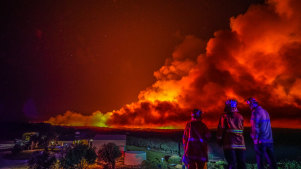A federal government directive that the offshore environment regulator ignore the oil and gas sector’s massive indirect emissions but consider its economic benefits could open decisions to legal challenge.
Resources minister Keith Pitt told the National Offshore Petroleum Safety and Environmental Management Authority he expected it to only consider the direct emissions from projects it assessed as later indirect, or scope 3, emissions were managed by countries that bought Australian oil and gas.
 |
| Gas is good: Resources Minister Keith Pitt. Credit: Alex Ellinghausen |
Environmental Defenders Office managing climate lawyer Brendan Dobbie said Mr Pitt’s expectation on emissions conflicted with NOPSEMA’s legal obligations.
“The regulations specify that NOPSEMA must consider both direct and indirect impacts of offshore gas projects,” Mr Dobbie said, including scope 3 emissions.
 |
“At a time when the scientific consensus tells us that the development of any new fossil fuel project will cause us to miss our Paris targets, it is imperative that NOPSEMA consider the full scope of greenhouse gas impacts caused by Australian offshore gas projects.”
Like Mr Pitt, the Australian gas industry has argued scope 3 emissions are not its responsibility, but its customers’.
However, most direct emissions from many Australian gas projects are classified as scope 3 emissions by NOPSEMA as the heavily polluting plants that cool the gas to a liquid for export are located onshore, outside its jurisdiction.
Woodside’s Scarborough, the LNG project most recently assessed by NOPSEMA, will emit about 0.5 million tonnes of carbon pollution a year offshore, processing onshore at Woodside’s Pluto plant will produce 2.8 million tonnes and use by its mostly overseas customers another 25 million tonnes.
If NOPSEMA ignored what it considered to be scope 3 emissions then 85 per cent of the emissions within Australia under the control of the gas producer would escape its attention.
The exclusion of scope 3 emissions would ease the regulatory path for offshore gas producers.
Woodside’s $16.6 billion Scarborough project and Santos’ $5 billion Barossa project have both had high-level project proposals accepted by NOPSEMA but must still get numerous environment plans approved by the regulator for each stage of construction and operation.
Existing projects, such as Chevron’s Gorgon and Wheatstone, would also benefit as NOPSEMA reviews their environment plans every five years.
 |
Mr Pitt’s letter to NOPSEMA, posted on the regulator’s website, also said the regulator played an important part in encouraging investment in the “globally competitive” oil and gas industry that is expected to produce exports of $76 billion this financial year.
“I expect NOPSEMA to consider the broader social, economic and commercial environment,” Mr Pitt said in the letter.
Mr Dobbie said regulations required NOPSEMA to only consider environmental issues when assessing environmental approvals.
“If NOPSEMA were to take into account economic and commercial matters when determining environmental approvals, it may fall into legal error and those approvals may be subject to challenge in the courts,” he said.
Mr Pitt’s expectation that NOPSEMA has a role in encouraging investment contrasts with the previous ministerial statement of expectations in 2019 by then-resources minister Senator Matt Canavan who said the regulator was kept separate from agencies that promoted the petroleum industry “to ensure its regulatory independence”.
Mr Pitt said the purpose of a ministerial statement of expectations was to provide greater clarity about government policies and objectives that were relevant to the regulator.
“It is regulatory best practice for an independent regulator to fully consider the broader social, economic and commercial environment,” Mr Pitt said.
Mr Pitt was asked if he sought legal advice on whether NOPSEMA could meet his expectations to ignore scope 3 emissions and consider non-environmental issues and still meet its legal obligations but did not respond.
NOPSEMA chief executive Stuart Smith has two months to respond to Mr Pitt outlining how the regulator will meet the minister’s expectations.
Links
- 'We'll keep mining': Australia resists climate policy pressure
- Keith Pitt: Ministerial Statement of Expectations (pdf)
- We can't say anything concrete about how Keith Pitt voted on treating government action on climate change as a matter of urgency
- Australia's Resources Minister Keith Pitt dismisses UN chief's climate change statement
- Australian resources minister attacks ‘green activists’ for trying to ‘cripple’ fossil fuel companies
- The men in power who have stalled Australia’s climate action
- Pitt 'ignored climate risks' of NT project






